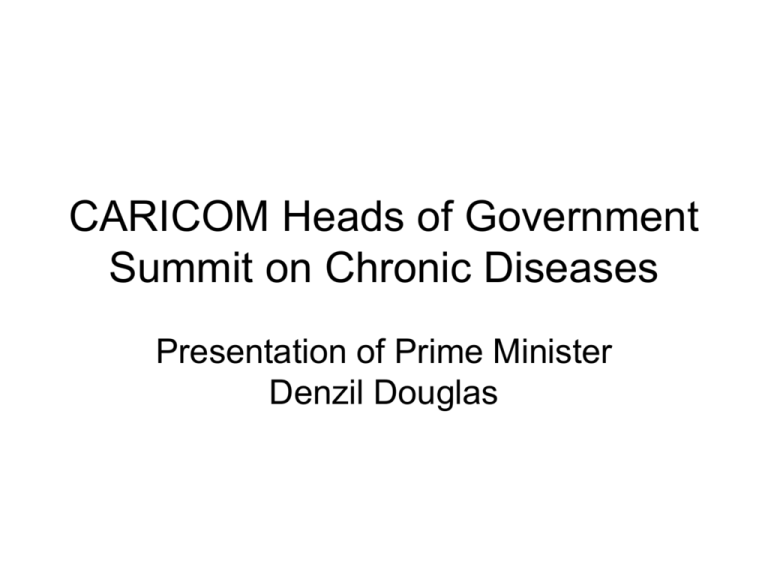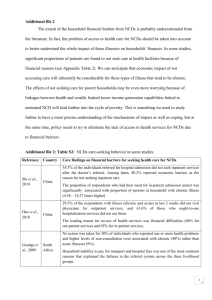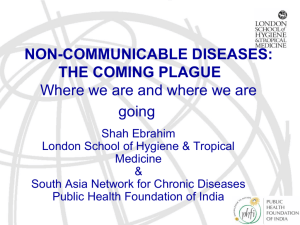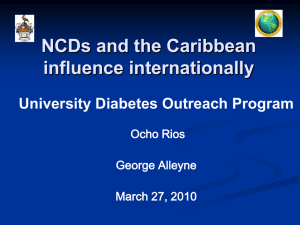Summit Presentation
advertisement

CARICOM Heads of Government Summit on Chronic Diseases Presentation of Prime Minister Denzil Douglas Overview of Presentation • • • • • • Global situation with Chronic NCDs Caribbean situation and costs Caribbean Response Exploding common myths Review of effective interventions The Way Forward – Addressing the risk factors • Globalisation and health Globalisation and Health THE MALADIES OF AFFLUENCE The Economist, August 11th 2007 The poor world is getting the rich world’s diseases “Europeans have been exporting their maladies throughout history. They seem to be doing it again, but in a new way. In the past the problem was infection. Now illnesses associated with Western living standards are the fastest growing killers in poor and middle-income countries. Chronic disease has become the poor world’s greatest health problem”. The Economist, August 11, 2007 Chronic Diseases and their Causes Chronic Diseases Heart Disease, Stroke, Cancer, Diabetes, Chronic Respiratory Disease ↑ Biological Risk Factors Modifiable: overweight, high cholesterol, high blood sugar, high blood pressure Non-modifiable: Age, Sex, and Genetics ↑ Behavioral Risk Factors Tobacco use, physical inactivity, unhealthy diet, alcohol abuse ↑ Social and Environmental Determinants Social, economic and political conditions such as income, living and working conditions, physical infrastructure, environment, education, agriculture, and access to health services ↑ Global Influences Globalization of food supply, urbanization, technology, migration Distribution of Deaths by Major Cause in the World Distribution of Deaths from Infectious and Chronic Disease by Income Category, 2005 Crude Mortality Rates (per 100,000 population ) for Select Diseases: (2000-2004) CARICOM Member States 140 120 Heart Disease Rates per 100,000 population 100 Cancers 80 Diabetes Stroke 60 Injuries Hypertensive Diseases 40 HIV/AIDS 20 0 2000 2001 2002 Year Source: CAREC, based on mortality reports from countries 2003 2004 Leading Causes of Death in CARICOM Countries by Sex, 2004 (MINUS Jamaica) FEMALES MALES 1. 2. 3. 4. 5. 6. 7. 8. Heart Disease Cancers Injuries and violence Stroke Diabetes HIV/AIDS Hypertension Influenza/pneumonia 1. 2. 3. 4. 5. 6. 7. 8. Heart Disease Cancers Diabetes Stroke Hypertension HIV/AIDS Influenza/pneumonia Injuries and violence Source: CAREC, based on country mortality reports Potential Years of Life Lost <65 Potential Years by of Life Lost <65years by main causes, years main causes, 20002000 & 2004, CARICOM countries (minus Jamaica) and 2004, CARICOM countries (minus Jamaica) Injuries Y2004 HIV/AIDS Y2000 Chronic Disease 0 10000 20000 30000 40000 50000 60000 70000 Source: CAREC, based on country mortality reports Note: Chronic Disease includes heart disease, stroke, cancer, diabetes, hypertension, chronic respiratory disease. Injuries includes traffic fatalities, homicide, suicide, drowning, falls, poisoning Disability Adjusted Life Years 2002 Disability Adjusted Life Years (000) 2002 300 250 200 Com Dis NCDs 150 100 50 0 JAM TRT BAH BAR Mortality Attributable to Select Risk Factors (Latin America & Caribbean), from DCP2 High BP Obesity Alcohol Tobacco High cholesterol Low fruits & veg Physical inactivity Unsafe sex 0 100 200 300 Attributable Deaths (thousands) 400 500 Trends in Adult Trends in Adult Overweight/Obesity Overweight/Obesity in the in the Caribbean 60 Caribbean Prevalence (%) 50 40 30 Male Female 20 10 0 1970s 1980s YEARS 1990s Prevalence (%) of diabetes among adults in the Americas 16.4 Barbados Trinidad/Tobago Jam aica Belize Cuba Mexico USA Nicaragua Surinam e Bolivia Guatem ala Colom bia Costa Rica Argentina Brazil Haiti Paraguay Urban Peru Chile Honduras 12.7 12.6 12.4 11.8 10.7 9.3 9 8.7 8.6 8.4 8.2 7.9 7.6 7.6 7.3 7.2 7.2 6.3 6.1 Source: Pan Am J Public Health 10(5), 2001; unpublished (CAMDI), Haiti (Diabetic Medicine); USA (Cowie, Diabetes Care) Caribbean trends in Diabetes mortality 80 Rate/100,000 70 60 Male Female 50 40 30 20 1985 1990 1995 2000 A consequence of Diabetes Amputations at the QEH 2002-2006 Diabetic Non diabetic Male 308 116 Female 379 120 Total 995 236 Source A. Hennis, 2007 Age adjusted death rates/100,000 population from Diabetes (2000) 120 100 80 60 40 20 0 BAH BAR GUY JAM SUR TRT CAN USA From community surveys, the prevalence of hypertension in adults 25-64 years of age was: Barbados 27.2 % Jamaica 24.0 % St. Lucia 25.9 % The Bahamas 37.5% Belize 37.3% Trinidad TBD Control of blood pressure would reduce the death rates from Cardiovascular Disease by about 1520%. Principal Clinic Visits, 20,000 Saint Vincent & the Grenadines, 2000 vs 2003 15,000 2000 10,000 2003 5,000 0 HTN or HTN/DM DM or DM/HTN Arthritis/Muscu Age adjusted death rates/100,000 population from Hypertension (2000) 50 45 40 35 30 25 20 15 10 5 0 BAH BAR GUY JAM SUR TRT CAN USA Projected National Income Lost from NCDs Projected national income lost from NCDs ( 2005-2015) 2005 -2015, $USBN 600 500 400 300 200 100 0 Bra Can Chi Ind Nig Pak Rus UK Tan Possible economic burden ($US Million, 2001) BAH BAR JAM TRT 27.3 37.8 208.8 494.4 Hypertension 46.4 72.7 251.6 259.5 Total 110.5 460.4 753.9 Diabetes 76.7 Total cost of DM and H/T as percent of GDP 8 7 6 5 4 3 2 1 0 BAH BAR JAM TRT Exploding the Myths • Myth: Chronic diseases are a problem of the rich countries Fact: Non-communicable disease account for more than half the burden of disease and 80% of the deaths in the poorer countries which carry a double burden of disease. Developing countries carry a double disease burden Percentage of deaths by cause Low- and Middle-income countries High-income countries 6% 10% 7% 54% 36% 87% non-communicable diseases communicable diseases injuries Exploding the Myths Myth: NCDs are a problem only of the elderly Fact: Half of these diseases occur in adults less than 70 years of age and the problems often begin in the young e.g., obesity Myth: NCDs affect men more than women Fact: NCDs affect women and men almost equally and globally, heart disease is the largest cause of death in women. Exploding the Myths Myth: NCDs cannot be prevented Fact: If the known risk factors are controlled, at least 80% of heart disease, stroke and diabetes and 40 % of cancers are preventable, and in addition there are cost-effective interventions available for control. Exploding the Myths • Myth: people with NCDs are at fault and to be blamed because of their unhealthy lifestyles • Fact: individual responsibility, while important, only has full effect where people have equal access to healthy choices. Governments have a crucial role to play by altering the social environment to help make the healthy choice the easy choice. Exploding the myths • Myth: “my grandfather smoked and lived to 90 years”, and “everyone has to die of something” • Fact: While some people who smoke will live a normal lifespan, the majority will have shorter, poorer quality lives. And yes, everyone has to die, but death does not need to be slow, painful or premature, as is so often the case with NCDs What works? • A small shift in average population levels of several risk factors can lead to a large reduction in chronic diseases • Population wide approaches form the central strategy for preventing and controlling chronic disease epidemics, but should be combined with interventions for individuals • Many interventions are not only effective, but suitable for resource constrained settings Finland: Dramatic Declines in NCD Mortality Relation of fitness to mortality T&T, St. James Cardiovascular Study • 1309 men had blood sugar, cholesterol, fitness measured at baseline and then followed up carefully for 7 years. • Unfit men compared with fit men were: - 3.6 times more likely to die - 2.5 times more likely to have a heart attack Caribbean Responses • Since the 1960s, history of collective action in health, formalized in 1986 as the Caribbean Cooperation in Health (CCH) initiative. • Countries, CAREC, CFNI and CHRC, CARICOM secretariat, PAHO/WHO and partners have had successes e.g.,, malnutrition and gastroenteritis, vaccine preventable diseases, HIV/AIDS (p (PANCAP). • CCH now entering 3rd phase: major thesis that Caribbean health can be improved through actions taken universally and collectively. • Current priorities for action under CCH include chronic diseases where the cited goals are to reduce deaths by 2% per year and to reduce serious, costly complications such as amputations or renal failure. Caribbean Responses Summarised A N G A N T B A H National focal point, Department or Unit National law, legislation, decree B A R G U Y H A I J A M S U R T R T National Objectives Implementation of DPAS National system of Health reports, survey and surveillance Demonstrative community-based programs National standards and protocols for treatment Implementation of FCTC Quality assurance of care Financial resources Source: PAHO Survey of NCD National Response Capacity, 2005 Addressing the risk factors Tobacco and alcohol • Increase taxes with proceeds to prevention and treatment • Ban smoking in public places • Ban smoking in all schools • Ban cigarette and tobacco advertising near to schools • Curtail promotion of alcohol products targeted to women and children • Establish target dates for passage of the legal provisions in the FCTC already ratified. Addressing the risk factors Physical activity • Have physical education compulsory in schools and provide the facilities • Provide healthy, secure exercise spaces • Provide wellness centers • Give tax relief for worksite exercise facilities Addressing the risk factors Improve dietary practices • Promote a standard of meals in public eating places eg. eliminating trans fats • Provide healthy school meals • Establish community based networks for training in preparation of health foods • Mandate RNM to investigate the trade issues which impact negatively on healthy food imports • Promote elimination of trans fats from Caribbean diets Addressing the risk factors In the case of cancer • Primary prevention Eg screening and vaccination to prevent cervical cancer Promote screening for breast cancer Secondary prevention • Screening programs for NCDs • Provide health services with resources to apply the established cost-effective interventions • Establish mechanisms to ensure availability of the medications necessary for the long term treatment of NCDs when they occur Critical other recommendations • Establish national level Commissions on NCDs • Mandate CAREC to establish a system of behavior and risk factor surveillance • Insist on the updating of the Caribbean Regional Plan of Action for NCDs • The Caribbean should name a “CARIBBEAN WELLNESS DAY” Involve Partners • PAHO/WHO • Financial institutions • Caribbean social partners – private sector and civil society Monitoring and evaluation • Designate CARICOM/PAHO as the joint Secretariat with responsibility for monitoring and reporting progress in the control of the NCDs. The way forward First: We can utilize the policy instruments at our disposal legislation taxation regulation Second: We should establish partnerships Third: We must take personal responsibility and lead by example CONCLUSIONS • The Caribbean has a very serious problem - getting worse • Economically and socially, it is not sustainable • There are cost-effective interventions that work; why not utilise them? • We must put into effect National and Caribbean-wide (CCH) plans • It is CRITICAL to strengthen health services to for management and control of chronic diseases • Deepened partnership with public and private sector, and civil society absolutely needed







